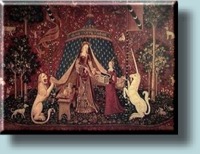|
|
TO THE READER The Web of What Is Written is a work that first came to me in 1973-4, and whose basic design has remained unchanged through several revisions, none yet final. It came about when someone asked me at short notice to teach a course on the modern novel. Not knowing how to choose the materials, I decided to act on an aesthetic hunch – choose a group of novels that seemed to “go together” and trust that connections among them would show up. They did. As the class and I talked through the seven novels that were eventually discussed, a common pattern of event and imagery unfolded, until it seemed as if we were discussing one book. This pattern of event and imagery appeared to center on the relationship between writer and reader, and the fate of the surrounding community. No doubt I tuned into this pattern because I had recently lived through a version of the story (as related elsewhere on this site, in Soul’s Evidence.) Not satisfied with how this story tends to turn out, I then thought of teaching another course, which I called “Toward a Philosophy of the Use of Poetry,” based on several texts which had spoken to me of better outcomes. After giving these courses, it occurred to me to try to hold the configuration fast in a document, for which the title The Web of What Is Written, with its abbreviation WWW, suggested itself. It was not the first time I had been drawn to the idea of the Internet as a metaphor, even before the www was in existence. A cryptic saying by Paul Celan – “Every poem is the anti-computer, even the one the computer writes” – had linked itself in my mind with a joke told by a mathematics student in the ‘60’s: They hooked up all the computers in the world into one big computer, and then they held an inauguration ceremony. They wanted to ask the computer a really big question, and finally decided on "Is there a God?" The answer came back: "There is now." If computers could enhance their computing power by being joined into a network, then might not poetic minds also form a network with an unprecedented visionary and communicative power? There are formidable obstacles to the realization of such a possibility, but perhaps, if what we have to gain could be seen clearly, these obstacles could be overcome. In writing this book (as in the encounter with Paul Celan that preceded it) I had the sense of stumbling upon a tremendous mystery, which has not proved easy to talk about in the right way. For one thing, The Web of What Is Written is an associative work. Literary and personal associations played a key role in these interpretations. How much to put in, how much to leave out, was always a question. And then, the question of tone. The impersonal scholarly tone was impossible for me vis-à-vis the subject matter (that was what had driven me out of the academic world). This work of criticism was, more obviously than usual, a work of autobiography. But I did not want to clutter it up with the merely personal, either. And then, the human soul is a china shop through which a good many psychoanalytic bulls have gone charging in recent memory; the wisdom of following in their wake has to be deliberated. I understand that in Judaism there are esoteric matters which are not directly discussed between teacher and pupil; only the “chapter headings” are given. In the menu to the right, the reader will find the headings to the various chapters, which I hope someday to feel right about posting. Meanwhile, some of the perceptions that form the basis for The Web of What Is Written have been expressed in a more recent essay on the Divine Comedy, to which many of the associative trails in “The Web” had led back. This essay, “Continuing the Conversation on Dante,” may be found here. The title, The Web of What Is Written, had ambitions of being the title not only of a “master document” linking those works discussed in 1973 into a “metanovel,’ but of the entire vast web of literature, the limitless text, all of it linked together in one way or another. There is nothing unique in this work’s perception of “intertextuality.” What is perhaps unique is its discovery of a certain number of works that are bound particularly closely, and in which reflection on the literary calling and its implications is concentrated. There are other perspectives from which to approach that subject -- for instance the perspective of Ethics of the Fathers, quoted at one point by Harold Bloom (to whose "anxiety of influence" and "map of misreading" this work is partly a retort): "You are not required to complete the work, neither are you free to desist from it.
|

